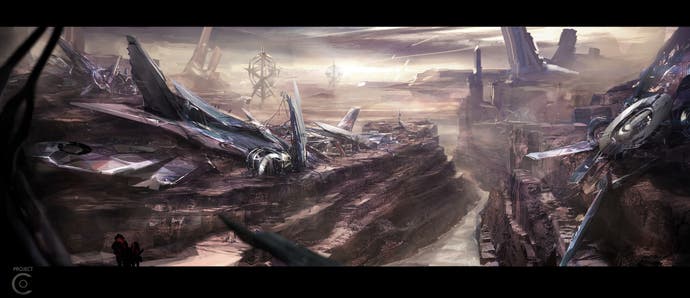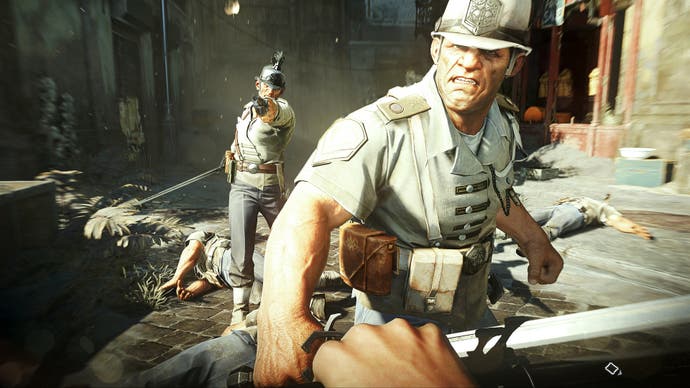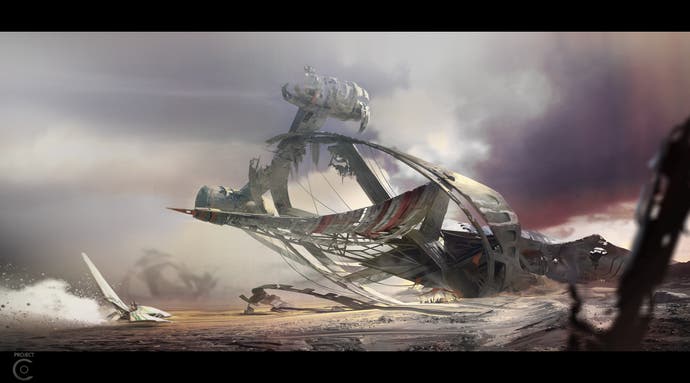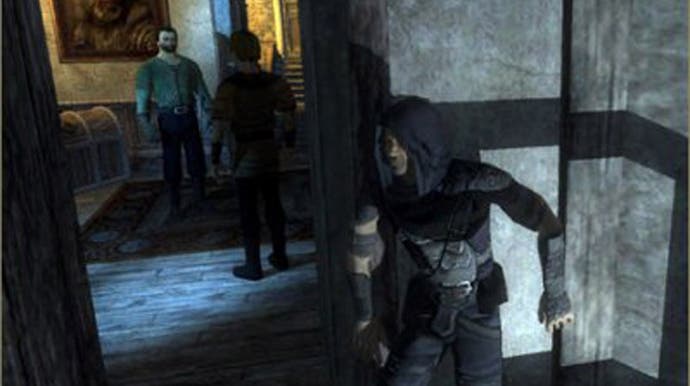The return of Randy Smith and the state of the immersive sim
"I don't think the genre is dead…"
If you're looking for an expert on immersive sims, speak to Randy Smith.

The 43-year-old American game designer, who lives in Austin, Texas, cut his teeth on the Thief series while working at both Looking Glass and Ion Storm, the two studios considered to have birthed the genre.
After Thief, Smith collaborated with Half-Life 2 art director Viktor Antonov at Arkane, developer of the recent Dishonored and Prey immersive sims, on projects that never came out. Meanwhile, in 2008 Smith, alongside fellow designer David Kalina, founded a new studio called Tiger Style, and designed indie games Spider: The Secret of Bryce Manor (2009) and Waking Mars (2012), before a Spider sequel, subtitled Rite of the Shrouded Moon, hit Steam in 2015. But unlike the first Spider game and Waking Mars, Rite of the Shrouded Moon flopped.
"I think the best way to summarise the story is the next GDC, we gave a talk called the indiepocalypse - what happened to the state of the indie market?" Smith laughs when we meet at the Game Developers Conference in San Francisco last week.
"Our company wasn't making the kind of games that were easy to make your money back on or have a good ROI [return on investment] for the future. We didn't have a business development team. We were a very small two-man shop with a bunch of collaborators.
"So, we decided to stop doing that."

David Kalina went on to do contracting work on survival adventure game Subnautica (which is very good, by the way). Randy Smith also returned to contract work. Then, his old friend Viktor Antonov got in touch.
"He said, hey, I've been working with these cool guys in Paris. They have some really neat projects and ideas and business models and they could really use somebody who has your design mentality."
The "cool guys in Paris" turned out to be a studio called Darewise, a small outfit made up of just a dozen or so staff. At first, Smith worked with them as a part-time contractor, spending a year to help flesh out various ideas. He came on full-time not long ago to focus on one game in particular: the mysterious Project C.

Project C is in pre-production, and so when you talk to Smith about it, he can only answer in vague terms. But we do know some things about it that help provide an idea of what to expect.
Project C is a sci-fi third-person action open-world game with "meaningful persistence". It's set on a planet designed to be a living, breathing virtual world, a place that reacts as much to itself as it does to players. Speaking of players, this is a multiplayer-focused game. In fact it sounds sort of like an MMO. Speaking to Smith, Project C sounds like Eve Online meets Mass Effect meets... Second Life?
It certainly doesn't sound like the future of the immersive sim, which is the genre Smith is known for, but there are elements of it in the game.
"In the Thief series, one of the things players loved about those games was, it's not that the guard is a wandering monster who appears in front of you and then you have to deal with him," Smith explains. "The guard has his whole virtual life where he has a patrol route and he notices things in his environment and he talks to his friends.
"If the player comes to an understanding of these simulations, they can perform better at the game. They can realise the guy is going to be over here, and they're going to leave something out to distract him, and that will help them buy more time so they can get through this confluence of patrol paths. Players feel very clever and they feel like they own those experiences. That's the background I come from: heavy simulation, very player experience driven. Immersive.
"Some of that mentality has in the past been hard to bring to MMOs and that's what we're trying to do here. There's the notion of this big dangerous predator who walks around the environment, and the reasons players might care about different ways to respond to him.
"If a bear shows up, it's a bear, I fight it and I pick up loot, then that might as well have been just a random encounter. So, to design past that we need to know, why does the player care where this bear has been today, like where its nest is? Why might the player care where this bear is going? Is there a good reason to follow it, to try avoid being seen or try avoid working it up so it's in attack mode? Are you waiting to get into the right place so you can get it into attack mode, so it'll fight your enemies and cause a distraction? Do you want to follow its tracks back to its lair because you know it tends to collect a certain type of resource, and so if you're clever you can get that out without getting caught? But don't get him mad because he'll kill you, unless you band together with a bunch of friends and then you're able to take him down.
"So, it's that kind of immersive sim mentality of like, there's a rich simulation going on, if you understand it you can perform better at the game and it'll give you more options as a player. And that's just the ecosystem, that's just the creatures. Of course we have the social layers, the sandbox stuff, and there's gear and equipment you can customise."

Darewise has unveiled Project C at an interesting - perhaps crucial - juncture for the immersive sim. After a triumphant return in 2012 with Arkane's superb and commercially successful Dishonored, the genre has seen notable sales disappointments that have left fans worried for its future.
In February 2014, Eidos Montreal's long in development Thief reboot came and went without moving the needle. In August 2016, Eidos Montreal's Deus Ex sequel Mankind Divided similarly struggled to capture the attention of the wider gaming audience. (As we reported, don't expect a new Deus Ex game any time soon.)
October 2016 saw the release of Dishonored 2 and then, just half a year later, Prey came out. Neither game set tills alight, despite positive reviews from critics. And then, in September 2017, Arkane launched Dishonored expansion Death of the Outsider. Over the course of just four years, we've seen four big-ticket immersive sims and a major expansion. (It looks like Prey will get some DLC soon, too.) Arkane has so far kept the quality of its games right up there, but if the world's most celebrated immersive sim studio can't make a commercial success out the genre, then is that genre under threat? After all, Arkane's owners at Bethesda won't bankroll critically-acclaimed losses forever. Maybe the studio will change tack. It looks like Square Enix, owner of Eidos Montreal, has given up entirely.
"I don't think the genre is dead," counters Randy Smith, who has his own theories for why recent attempts struggled in terms of sales.
"Prey and Dishonored are amazing, well-designed games. I have yet to finish Dishonored 2 despite the fact many of my friends worked on it. That's because we live in 2018 and we're bombarded with dozens of games that are important, that you should check out, that are relevant to your work. And so, you have to pick and choose and make decisions as a consumer, and I think the consumer just played Dishonored a few years ago and maybe they're not in the mood for that. Or maybe sci-fi isn't big and that's why Prey didn't work out - or that particular flavour of sci-fi. They want to play the new game by the guys who made FTL instead. There are just a lot of choices out there."

Smith's comments touch on the thought that there wasn't much of an appetite for a follow-up to Dishonored, and Prey failed to spark excitement because it came out soon after. Why the immersive sim would suffer more than other genres from such a scheduling issue is clear: the immersive sim is not a pick-up-and-play type of experience. These games are all or nothing - they can, and for their hardcore fans should, be played for hundreds of hours as their virtual innards are squeezed to within an inch of their life, their mechanics mastered and their many enemies now little more than puppets on a mouse and keyboard made out of string.
"My sense is immersive sims are big, heavy ponderous games that really involve the player," Smith says.
"Maybe you don't need one every year. Maybe you don't need three every year. It's a more crowded market, just because the market can bear less attention.
"Certainly, we've always had mega fans who'll play anything we put out, all the way through, back to back, every character, every level, and then go through it in ghost mode. But the average consumer just wants to have a cool immersive sim every couple of years."
One of the other big issues with the immersive sim genre - and certainly Arkane's recent output - is its difficulty. Immersive sims skew harder than other genres. They certainly demand more of the player than your average shooter. Mastering the often many mechanics can be a significant challenge for players. Stealth is one of those inherently challenging gameplay types. And many of Dishonored 2 and Prey's best moments can fuse huge numbers of elements into one ultra hard difficulty spike.
Randy Smith acknowledges this issue.
"I think Dishonored 1 was a little bit more fun on that axis, but I don't know that Dishonored 2 and Prey did themselves any favours in approachability," he says.
"The world and the story are very approachable, but it's a little daunting when you're like, oops, I'm stuck in the Clockwork Mansion and it's going to take five more tries to figure out what I'm supposed to do to get out of here!"

And then there's that frustratingly fickle gamer to deal with. Video game genres go in and out of fashion. Today the Battle Royale genre is melting servers. Tomorrow it could be something else entirely. Perhaps people just aren't that into immersive sims right now.
"A lot of it is consumer mentality, zeitgeist," Smith says. "One of the things I started thinking about as soon as Trump was elected was, okay, how is America is going to feel 12 months from now and what kind of games are they going to crave? That's just an example of the zeitgeist flipping abruptly, and the thing you were working on you thought would take doesn't take."
So, what to do? If the immersive sim isn't dead, but it's hardly sauntering down the catwalk, either, what is it? And what can we expect of it in the years to come?
Randy Smith reckons easing up on the mechanics and going hard on the experience may be the way to go. In fact, some games are already doing this.
"We always see immersive sims that are about bionic assassins and these particular types of special characters in conflict-driven situations, and lots of cool magic and sci-fi tools to solve the problems," Smith says.
"I think there's more you can do with the immersive sim. Walking simulators have started to allude to that. There have been various games that have been a little lighter on mechanics and stronger on the experience, which is something immersive sims do very well."

Might Project C be considered the future of the immersive sim? Smith says it's helpful to firstly define what we mean by the immersive sim, so that we can say what the game is doing that's similar, and what it's doing that's different.
"The Irrational, Looking Glass, Ion Storm, that kind of single-player first-person systems-driven game - that's how I would identify an immersive sim," he says.
"In that case no, we are not doing that. But we are borrowing many principles that create player options in particular and trying to figure out how those work in a massively multiplayer environment.
"We think of this [Project C] not just as a fighting game with lots of different tools and you're a bionic assassin or whatever, we think of it as a place where you can have a virtual life. Hey, if you want to come in here and be the guy who just scouts to figure out where enemies are putting up their encampments, that's a role you can have. If you want to be the guy who figures out where the cool resources are growing so the other convoys can come in and try to harvest those materials, that's an opportunity. These are the types of things we're hoping to provide players."
Project C, then, might be better described as the distant future of the immersive sim, which leaves the immediate future of the genre unclear. What is certain is that Project C is ambitious - and it's trying to do a lot of things all at once. Reference points include Mass Effect in terms of its action-packed, sci-fi themes, Eve Online in terms of the way players tell their own stories through emergent gameplay, and Aliens vs Predator and Team Fortress 2 in terms of their combat. Like I said, ambitious.
But this is a game with Randy Smith, with all his immersive sim experience steering the design, and Viktor Antonov, with City 17 and the Combine architecture and technology under his belt, creating the look and feel of the world. The team is currently 20 strong, but it will be 30 people by the summer, I'm told, all working in Paris.
Oh, and Randy Smith in Texas. He is the expert, after all.

